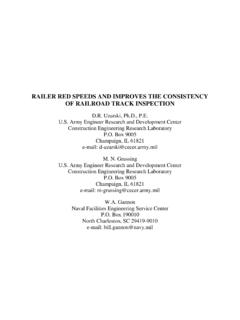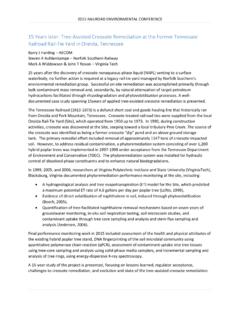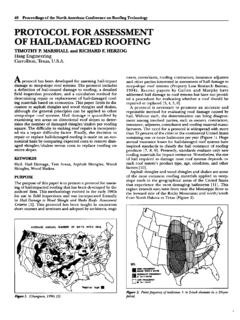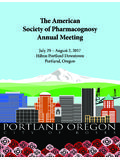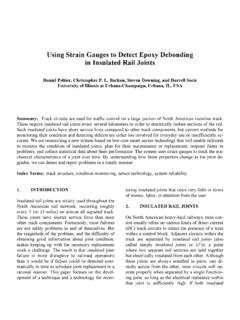Transcription of /LQHVL Q1RUWK$ PHULFD - UIUC RailTEC
1 RailLille 2017 7th International Conference on Railway Operations Modelling and Analysis M USSANOV DARKHAN, N ISHIO N AO, D ICK C. T YLER. Delay Performance of Different Train Types Under Combinations of Structured and Flexible Operations on Single-Track Railway Lines in north America Darkhan Mussanov a, 1, Nao Nishio a, C. Tyler Dick, PE a a Rail Transportation and Engineering Center ( RailTEC ), Department of Civil and Environmental Engineering, University of Illinois at Urbana-Champaign 205 N Mathews Ave, Urbana, IL 61801, USA. 1. E-mail: Phone: +1 (217) 244 6063. Abstract north american freight railroads typically operate flexible train schedules where train dispatchers resolve train conflicts in real-time.
2 This is in contrast to Europe, Asia, or rail transit networks where structured train operations follow a pre-planned timetable. Under flexible operations, trains are dispatched as needed, making it an ideal approach for low- cost transportation of bulk commodities. Recently, north american railways have experienced a substantial decline in demand for bulk transportation of coal. However, demand for premium intermodal traffic that must operate on more rigid schedules has reached record levels. To handle both types of traffic efficiently, north american railways are faced with the challenge of operating both flexible and structured train schedules on the same route infrastructure.
3 This paper seeks to understand how different combinations of scheduled and flexible trains, the amount of schedule flexibility, and train priorities impact the performance of a single-track rail corridor. Rail Traffic Controller (RTC) simulation software was used to simulate different operating conditions for a fixed traffic volume on a representative rail corridor. The results suggest that efforts to reduce delay and improve level-of-service by reducing schedule flexibility show little return until operations become highly structured with little flexibility. Scheduled trains perform best when there are fewer flexible trains on the route while flexible trains are relatively insensitive to traffic composition.
4 Assigning priority to scheduled trains causes the overall average level-of- service to deteriorate. These general trends can help practitioners plan for operation of different scheduled and flexible train types on the same rail corridor. Keywords Scheduling, flexible operations, train delay, simulation, priority 1 Introduction north american freight rail traffic reached a peak in 2006 on the strength of heavy haul transportation of bulk commodities and double-stack containers in international trade (FRA. (2015)). Following three years of traffic declines due to economic recession, freight rail traffic has slowly returned to 2006 levels.
5 However, the composition and geographic distribution of this traffic has substantially changed. Coal traffic has declined by over 20. percent since 2006 while intermodal traffic has reached record levels (AAR (2016)). Domestic package delivery companies have driven the growth of domestic intermodal 759 / 1705. RailLille 2017 7th International Conference on Railway Operations Modelling and Analysis M USSANOV DARKHAN, N ISHIO N AO, D ICK C. T YLER. traffic by contributing premium traffic that requires predictable service on precise schedules. At the same time, there has been strong public and agency interest in expanding commuter and regional intercity passenger rail service on these same freight corridors.
6 Thus many rail corridors are experiencing a transition from bulk freight trains operating on flexible schedules to maximize efficiency and economies of scale, to premium services that require more structured operations with fixed arrival and departure times. Although, passenger, commuter and premium intermodal trains receive higher priority on the shared corridors compared to bulk and manifest traffic, maintaining the schedule flexibility of bulk freight trains while simultaneously providing the precision and level-of-service required by passenger and intermodal trains presents a substantial operational challenge on the predominantly single-track north american rail network.
7 To help increase the level-of-service of a single-track railway network with different train types, railways may add passing sidings (passing loops), extend siding lengths, and add double track. These actions can increase line capacity, reduce delay or allow for more flexible operations but the infrastructure projects are capital intensive and each railroad needs to maximize their return on infrastructure investment. Understanding the capacity and level-of-service impact of altering the number of trains that depart precisely with the timetable and according to flexible schedules can aid practitioners in evaluating operating plans and potential infrastructure investments.
8 This paper seeks to understand how different combinations of scheduled and flexible trains impact the performance of a single-track rail corridor. Simulation experiments were conducted to examine how increasing the number of flexible trains within baseline traffic of all scheduled trains alters the performance of a representative rail corridor. The results of the experiments provide a better understanding of the fundamental relationships between the proportion of scheduled and flexible trains, amount of schedule flexibility, and train delay. The findings of this paper are not intended to suggest that one type of operation is better than the other but rather to help practitioners consider the interaction of flexible and scheduled trains in evaluating line capacity and infrastructure investment.
9 2 Background Railway operations can be classified into two broad types: scheduled and flexible (Figure 1). Under scheduled operations, all of the trains in the network depart according to a pre-planned timetable with a fixed departure time and fixed arrival time (Figure 1a). The timetable is constructed such that any conflicts between trains are resolved and if the same timetable is executed each day, the same trains will meet and pass at the same locations each day. This kind of operation is very common in passenger and transit networks and railways in Europe and Asia. Precise operation according to a rigid timetable has also been termed structured operation (Martland (2009)).
10 Under flexible operations, trains do not have a fixed timetable and depart terminals as needed or within a range of pre-determined departure times. Most north american freight trains are operated in this manner, with train dispatchers routing the trains and resolving conflicts in real-time (Sogin (2013a)). Since train meets and passes occur at different locations each day, the running time of individual trains can vary greatly. Thus flexible trains, also referred to as unscheduled trains, exhibit both flexible departure times and flexible running times over the route (Figure 1b and 1c). The result is that flexible trains have variable arrival times at terminals or the ends of route segments under study.
